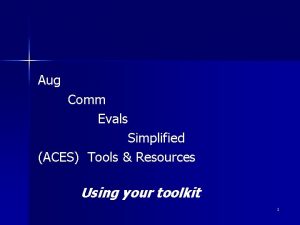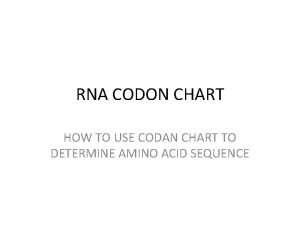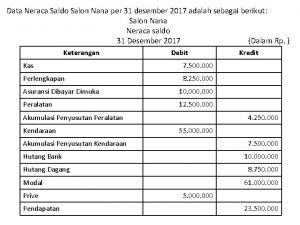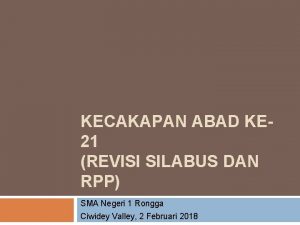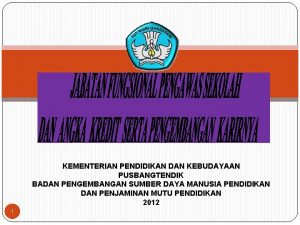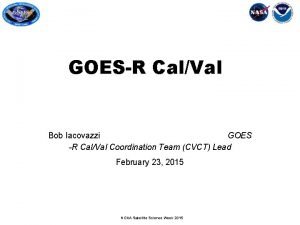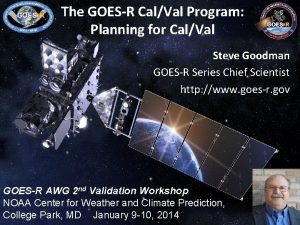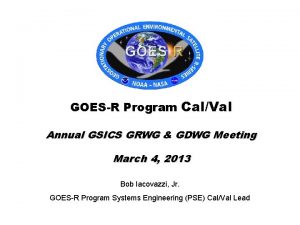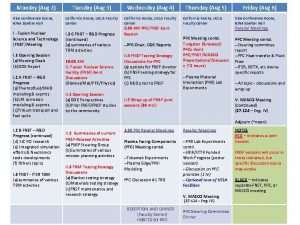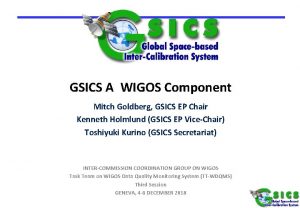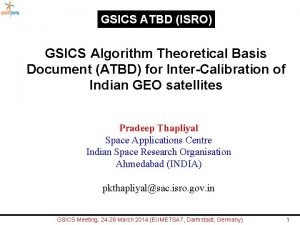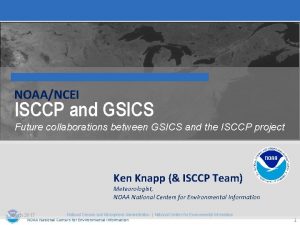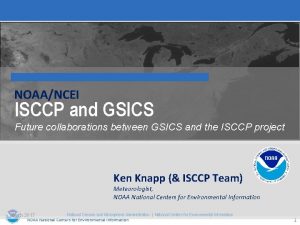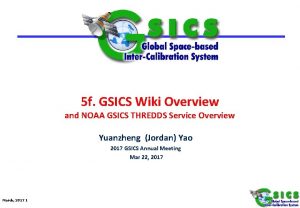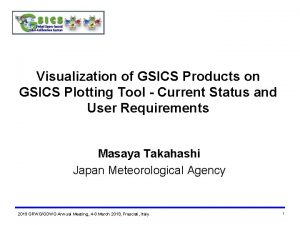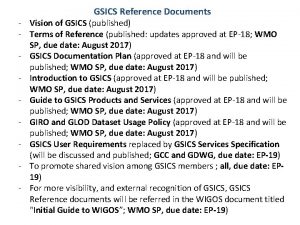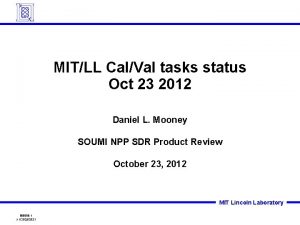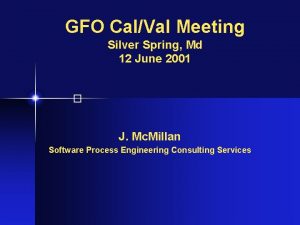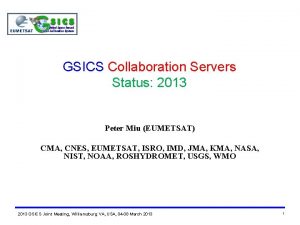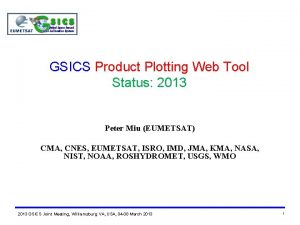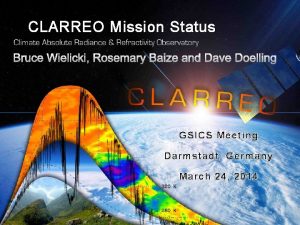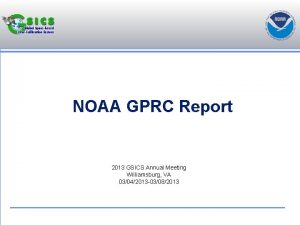GSICS Meeting Aug 6 2013 CalVal Status of



























- Slides: 27

GSICS Meeting, Aug 6, 2013 Cal/Val Status of FY 3 B-MWRI Hu(Tiger) Yang 1 and Fuzhong Weng 2 1. ESSIC, University of Maryland 2. NESDIS/STAR, NOAA huyang@umd. edu Aug 6, 2013

Contents q. New characteristics of FY 3 B-MWRI q. Data quality and observation stability q. Calibration accuracy and primary products

FY 3 B Orbit characteristics Orbit type Altitude(Km) Incline angle Orbit period eccentricity Orbits/day Revisit time Ascending LST Sun-synchronous 830 98. 75 101. 603 min 0. 0025 14. 1728 5. 5 days 13: 40~ 14: 00 Instrument characteristics Freq(GHz) 10. 65 18. 7 23. 8 36. 5 89 Pol V, H V, H BW(MHz) 180 200 400 900 3000 NEd. T(K) Cal Accuracy(K) Nonlinearity Pol isolation (d. B) Main beam efficiency FOV (Km Km) 0. 6 2. 0 <=2 k ≥ 20 90% 0. 8 2. 0 1. 2 2. 0 51 85 30 50 Swath width(Km) View angle( ) Samples/scan Scan period (s) Scan time error(ms) Rotating part static unbalance Momentum unbalance Observation mode 27 45 18 30 9 15 1400 45 254 1. 8 0. 1* ≤ 1 ms 17 kgmm 5000 kgmm 2 Calibration mode; 1. 7 s scan; 1. 8 s scan; 2. 0 ss can

Block Diagram of MWRI Receiver 10~36 GHz 89 GHz Detector LN AMP Integerator

New characteristics of FY 3 B-MWRI § In-situ low speed dynamic balancing adjustment to decrease the vibration amplitude § On-orbit AGC value injection to decrease receiver non-linearity § Adjustable scan mode

Scan stability at 1. 8 s scan period(5 days statistic) Scan stability at 1. 7 s scan period

Non-linearity at RX temperature 25 o

Sensitivity comparison between FY-3 A and 3 B MWRI channel FY 3 BMWRI FY 3 AMWRI 89 v 0. 47 0. 54 89 h 36 v 36 h 23 v 23 h 18 v 18 h 10 v 10 h 0. 45 0. 13 0. 21 0. 19 0. 27 0. 22 0. 30 0. 28 0. 36 0. 13 0. 22 0. 23 0. 41 0. 24 0. 30 0. 21 0. 26

Channel FOVs Match and Geolocation Error Analysis channel 1. 8 S scan mode 1. 7 S scan mode C-track A-track 10 V 54 77 59 76 10 H 59 79 61 75 18 V 39 46 37 43 18 H 40 46 37 43 23 V 32 35 34 38 23 H 34 40 31 39 36 V 24 28 22 25 36 H 24 27 21 25 89 V 12 18 15 19 89 H 13 20 15 17 Channel FOVs Miss Match(km) Channel 1. 7 S scan mode C-track 1. 8 S scan mode A-track C-track A-track 10 GHz 11. 75 0. 7 13. 5 3. 45 18 GHz 6. 05 0. 15 8. 7 -0. 65 23 GHz 4. 05 -2. 45 6. 25 -1. 4 36 GHz -0. 95 0. 7 7. 3 1. 8


Observation Stability(1) Methods • 1. Stability evaluation from calibration data; • 2. Stability evaluation by using vacarious calibration method. Data: Nov. 17, 2010 – Feb. 29, 2011 MWRI Level 1 datasets.

Gain variation for 28 orbits Gain variation for 752 orbits

Observation Stability(2) Vacarious cold target Calibration Method(Ruf et al, 2000) Total 1741 orbits L 1 data from Feb. 1, 2011 to July 29, 2011 were used. Max-min Mean Std. 10 H 0. 42 79. 71 0. 14 10 V 0. 26 153. 87 0. 10 18 H 1. 64 95. 939 0. 48 18 V 0. 69 171. 81 0. 24 23 H 1. 26 109. 69 0. 37 23 V 0. 78 181. 64 0. 26 36 H 1. 66 127. 65 0. 61 36 V 0. 29 195. 81 0. 11 89 H 0. 33 158. 12 0. 12 89 V 0. 12 226. 01 0. 04 chan

Calibration Accuracy Evaluation by using “Double Difference” Methods Sat 1 L 1 Obs. TB 1 Sat 1 Model TB 2 CRTM Obs. TB 2 Sat 2 L 1 O-B Model TB 1 O-B CRTM Double Difference Sat 2 Inter-satellite Calibration Accuracy Evaluation

Instrument Characteristics For Inter-Satellite Calibration FY 3 B-MWRI Cetr Freq (GHz) 10. 65 V/H 18. 7 V/H 23. 8 V/H 36. 5 V/H 89 V/H Band. Width( MHz) AQUA-AMSRE TRMM-TMI 6. 9 V/H 10. 65 V/H 18. 7 V/H 23. 8 V/H 36. 5 V/H 89 V/H 10. 65 V/H 19. 35 V/H 21. 3 V 37. 0 V/H 85. 5 V/H 100,200,400, 350,100,200, 100, 500, 200, 900,2 x 2300 400,1000, 2000, 3000 Inci. Angle(deg) 53 55 53 Asc/Dec Local Time 13: 30/1: 30 variation 13: 40/1: 40

Difference between FY 3 B-MWRI and AQUA-AMSRE over Land Ocean channel Land Mean(K) Ocean Rmse(K) Mean(K) Rmse(K) 10 V 0. 117 4. 49 -1. 87 2. 67 10 H 0. 335 4. 03 -3. 91 3. 01 18 V 0. 072 3. 79 -0. 09 2. 42 18 H 0. 183 4. 21 -4. 12 2. 92 23 V 0. 738 2. 86 -2. 29 2. 1 23 H 0. 518 3. 69 -3. 18 2. 67 36 V -0. 463 3. 21 -2. 16 2. 35 36 H 0. 58 4. 08 -0. 96 3. 37 89 V 0. 104 1. 89 1. 19 1. 57 89 H 0. 288 3. 04 -0. 0998 3. 21

FY 3 B MWRI vs. TRMM TMI (From Wesley Berg, CSU, 2012) Double Difference using Optimal Estimation

GPROF 2010 Retrieval July 2011 (From Wesley Berg, CSU, 2012) AMSR-E MWRI Intercalibrated MWRI No Intercal • Initial results are very promising. Could be valuable addition(s) to GPM constellation if data can be acquired.

Calibration Accuracy Evaluation Uncertainty of warmload Uncertainty of cold sky Nonlinearity Uncertainty of Earth radiation from backlobe of hot-reflector Instrument sensitivity

MWRI calibration Bias budget 10 V 10 H 18 V 18 H 23 V 23 H 36 V 36 H 89 V 89 H 0. 32 0. 22 0. 01 0. 02 0. 04 0. 23 0. 32 0. 33 0. 69 0. 54 0. 30 1. 69 1. 18 0. 84 1. 30 0. 68 1. 02 0. 49 1. 07 0. 24 0. 65 0. 12 0. 24 0. 06 0. 31 0. 35 0. 37 0. 36 0. 35 0. 26 0. 24 0. 55 0. 64 0. 84 1. 16 0. 76 1. 36 0. 77 0. 86 1. 74 1. 27 1. 03 1. 46

MWRI Brightness Temperature at 23 GHz

Precipitation Rain rate retrieval results for typhoon “Songda” on May 27, 2011 from MWRI(left) and AMSR-E (right). Typhoon rain rate in black area retrieved from MWRI and AMSR-E are compared in detail. White means no observation, gray means no retrieval, green to purple is rain rate in mm/h

TPW Products MWRI TPW AMSR-E TPW

SEA ICE Sea ice concentration retrieval results over Arctic and Antarctic area from MWRI L 1 brightness temperature data.

Snow Water Equivalance Global distribution of SWE retrievals over Northern Hemisphere from MWRI (left) and AMSR-E (right). Unit is in mm. Green color means no observation, cyan is open water, white is ice, gray is snow free area.

Soil Moisture

Conclusion v Lessons learned from FY 3 A make big improvements of FY 3 B MWRI. The observation is quiet stable since its launch on November , 2010. v Inter-satellite calibration results of MWRI with other instruments show that the brightness temperatures from MWRI observation are consistent with other similar instruments. v Primary validation results show that retrieval products from MWRI TBs are highly consistent with existing similar products and can be used in different applications.
 Henry calval
Henry calval Translation
Translation Aug comm device
Aug comm device Codan chart
Codan chart Aug kodon
Aug kodon Kaugnayan ng noli at el fili
Kaugnayan ng noli at el fili Solo duo trio quad penta hexa
Solo duo trio quad penta hexa Aug q
Aug q Proposal kickoff meeting agenda
Proposal kickoff meeting agenda What is meeting and types of meeting
What is meeting and types of meeting What is meeting and types of meeting
What is meeting and types of meeting Today meeting or today's meeting
Today meeting or today's meeting Ipcc 2013
Ipcc 2013 2022-2013
2022-2013 Salon big data 2013
Salon big data 2013 2013 apes frq
2013 apes frq Landasan dan prinsip kurikulum 2013
Landasan dan prinsip kurikulum 2013 Tema iht kurikulum 2013
Tema iht kurikulum 2013 Videos
Videos 326 os kormányrendelet 2013
326 os kormányrendelet 2013 Data neraca saldo salon rini per 31 desember
Data neraca saldo salon rini per 31 desember Acculturation studies ib psychology
Acculturation studies ib psychology Eu gdp 2013
Eu gdp 2013 Madsciencelessons.com 2013
Madsciencelessons.com 2013 Mechanics ncea level 3
Mechanics ncea level 3 Ipk abad 21
Ipk abad 21 Liam one direction age
Liam one direction age Pusbangtendik 2013
Pusbangtendik 2013


